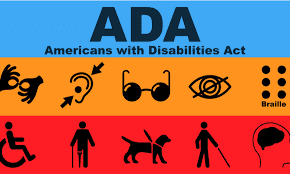MAY 2022, Vol 19, Issue 5
Overview
- Mental Health at Work
- Ten Steps to Comply with the ADA’s Interactive Process
- Mandated Training Available
Mental Health at Work
The federal government is increasing efforts to raise awareness of mental health problems in the workplace. Recently the U.S. Department of Labor (DOL) revealed its new public education campaign highlighting the importance of mental-health-friendly workplaces.
"Mental Health at Work: What Can I Do?" is an educational campaign that promotes healthy workplaces nationwide. The campaign helps employers understand the benefits of good mental health among employees as well as their role in making that happen.
U.S. Secretary of Labor Marty Walsh said "As America recovers from the COVID-19 pandemic, mental-health-friendly workplaces will be more important than ever. This timely public education campaign reminds us that we all have a role to play and that we all benefit from flexible, supportive workplaces that promote good mental health."
The campaign includes materials such as posters, behind-the-scenes video interviews, workplace mental health resources and tips for creating healthier workplaces. The DOL will also distribute a video PSA on this topic to television and radio stations nationally.
The PSA features a CEO, a manager, a co-worker and a person who identifies as having a mental health condition, who discuss the different ways workers can promote workplace well-being. These strategies include:
- Setting the tone for an inclusive workplace.
- Providing and requesting assistance and accommodations.
- Being a source of support to peers and colleagues.
- Asking what one needs to perform effectively.
"Mental Health at Work: What Can I Do?" coincides with a mental health crisis affecting millions of people in the U.S.
About 1 in 5 working-age Americans has a mental health condition. Yet less than half of adults dealing with mental illness—such as depression, bipolar disorder or post-traumatic stress disorder—sought treatment for their condition in 2020, according to the National Alliance on Mental Illness.
Mental health conditions are covered under the Americans with Disabilities Act. That means employers must make reasonable accommodations for workers with such disorders to perform their responsibilities if employees are willing to divulge their need for modifications.
- - - -
Ten Steps to Comply with the ADA’s Interactive Process
Many employers would appreciate a clear road map when traveling the often-winding roads of reasonable accommodations under the Americans with Disabilities Act (ADA). However, there are no rigid routes for the interactive process. After an employee requests an accommodation, the employer must engage in a good faith and flexible dialogue that addresses the employee’s specific medical limitation, request, job position, and work environment, among other factors. Below you can find guidance in at least ten hard and fast rules on the reasonable accommodation process:
- An employer’s statutory duty to provide reasonable accommodations may begin before the employment relationship even forms. If an applicant requests reasonable accommodations to enable participation in the hiring or interview process, an employer must provide an accommodation unless doing so poses an undue hardship.
- Generally, an employer’s duty to engage in the interactive process is triggered whenever it learns that an employee needs an accommodation. Courts give employees wide latitude in how they make this known. The employee need not make the request in writing, identify a specific accommodation, or use specific terms such as “disability,” “ADA,” or “reasonable accommodation.”
- To start the interactive process, the employer should gather information from the employee, including the specific nature of the limitation, the specific difficulty or issue that the employee is experiencing at work, and what sort of accommodation the employee is seeking.
- An employer may require that the employee provide documentation from the medical provider most familiar with the employee’s disability to confirm the employee’s specific limitations and need for accommodation.
- Once the employer receives this medical documentation, it should ensure that any subsequent requests for updated records are reasonable and do not create an undue burden on the employee. For example, rather than requesting updates on a weekly basis, an employer may seek updated medical information at a time that coincides with an employee’s next scheduled appointment if the doctor’s assessment may change at that time.
- Employers should keep all information collected from employees about their disabilities and need for accommodations confidential. All medical documents should be maintained in a standalone file separate from the employee’s personnel file.
- The employer should also be collecting information on its end as it reviews the information submitted by the employee. For example, the employer should be reviewing the essential functions of the employee’s position and the employee’s ability to perform those functions, and determining which reasonable accommodations, if any, would enable the employee to perform his or her job. An employer need not provide an immediate response to an employee’s request for accommodation, but it must address the request promptly and keep the employee informed of any updates in the process to ensure there is open communication. Document all communication throughout the interactive process.
- The goal of the interactive process should be to allow the employee to perform his or her existing job through a reasonable accommodation. However, even if this outcome is unfeasible, the interactive process is not over. Employers should then consider if they can accommodate the employee through reassignment to a different vacant position for which the employee is qualified or through a temporary leave of absence.
- An employee is entitled to a reasonable and effective accommodation – not necessarily the accommodation of his or her choice.
- If an employer can reasonably accommodate an employee, it is advisable to keep the interactive process open even after the accommodation is implemented. The employer should reach out to the employee to ensure that the accommodation was provided as discussed and that it is indeed effective in enabling the employee to perform his or her job.
- - - -
Mandated Training Available
HR Strategies, LLC can provide your organization with the mandated training required in Delaware. Contact our staff for scheduling and pricing:
- Delaware Harassment Prevention for Employees
- Delaware Harassment Prevention for Managers
- Drug and Alcohol Awareness
- Supervisor Reasonable Suspicion Testing Training
- - - -
*Contact HR Strategies staff at 302.376.8595 or info@hrstrategies.org if you would like support or would like to learn more about the items in this newsletter. Please contact us if you would like to be added to our Monthly Strategies mailing list or if you would like for us to add someone else to our list.*


